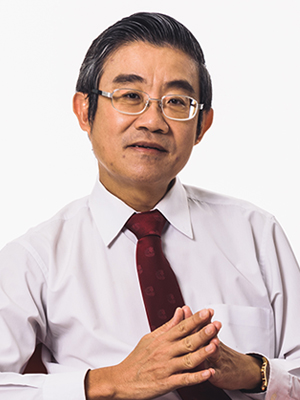Associate Professor Vincent TK Chow

DipMicrobiol, MD, FRCPath, MBBS, MSc, PhD
Associate Professor
Department of Microbiology and Immunology
Email: micctk@nus.edu.sg
Tel: 6516 3691
Research Interest
Host and Pathogen Interactivity Laboratory
- Mouse models for understanding the molecular pathogenesis of influenza and pneumococcal pneumonia.
- Activation and formation of neutrophil extracellular traps in severe influenza and secondary pneumococcal pneumonia.
- Genomics and proteomics of emerging and re-emerginginfectious diseases.
- Vaccine strategies, molecular surveillance and seroepidemiology of microbial infections.
Our laboratory is engaged in Molecular Genetics and Infectomics – the interface between emerging and re-emerging viral pathogens and host genes and proteins. A major focus is to adopt genomic and proteomic strategies for studying the infectomics of viruses/diseases such as influenza, enterovirus 71, dengue, SARS coronavirus, and human herpesvirus 6. The goal is to identify and analyse critical interactions between medically important viruses and host proteins that contribute to pathogenesis. We focus on the molecular genetics and infectomics of influenza pneumonia and of hand, foot and mouth disease, specifically on the cellular, molecular, and viral pathogenesis of severe influenza and enterovirus 71 infections.
The overall theme of our research on influenza is “Virology and immunology of human influenza and mouse models of influenza”. Our murine models of severe influenza pneumonia facilitate infectomics studies on influenza in vivo. These animal models are also harnessed to identify critical mutations in the influenza H3N2 virus that can enhance its virulence. The contributions of excessive cytokine signalling molecules and oxidative stress to lung damage during influenza pneumonia are also studied, with a view to countering their deleterious effects. Another key area is the repair of new lung tissue following damage by influenza infection, and testing novel therapies including growth factors to accelerate the regeneration of lung epithelium. Specific projects include: the role of neutrophil extracellular traps in pathogenesis; expression of influenza and other microbial antigens; human influenza monitoring, surveillance, molecular epidemiology and evolution.
We actively collaborate with clinicians, infectious disease physicians, laboratory medicine specialists, epidemiologists, basic scientists, bioengineers, chemists, and statisticians on key areas of influenza and pneumonia research. Pertinent examples of such research activities are: sequencing of viral genomes to study their epidemiology and evolution; identification of host biomarkers of severe influenza pneumonia; and pneumococcal pneumonia secondary to influenza. We are also studying the dynamics of influenza transmission in households, schools, hospitals, elderly homes, and in the community. Other studies include: evaluation of influenza vaccine efficacy in different age groups ranging from young to elderly subjects (including their antibody and cell-mediated immune responses); the waning of immunity with time; clarifying the uptake and utility of vaccination in reducing morbidity and mortality especially in high-risk groups.
Together with a multidisciplinary group of researchers, our team has developed and applied molecular tools for rapid diagnosis and molecular epidemiological surveillance of important human pathogens, including influenza, dengue viruses, enterovirus 71, human papillomaviruses, mumps virus, respiratory syncytial virus, varicella-zoster virus, Neisseria gonorrhoeae and Chlamydophila pneumoniae.
Previously, our Human Genome Laboratory has isolated and characterised several novel human genes and proteins, including HEP-COP (alpha-subunit of the coatomer protein complex); DENN (differentially expressed in normal and neoplastic cells); HUEL (SLC30A9, a member of the solute carrier superfamily); HALR (MLL3 associated with leukaemia); and MOST-1 (overexpressed/amplified in high grade cancers of the breast and prostate).
Recent Publications
- Rai P, Parrish M, Tay IJ, Li N, Ackerman S, He F, Kwang J, Chow VT, Engelward BP (2015) Streptococcus pneumoniae secretes hydrogen peroxide leading to DNA damage and apoptosis in lung cells. Proceedings of the National Academy of Sciences, USA, 112(26): E3421-30.
- Li L, Chong HC, Ng SY, Kwok KW, Teo Z, Tan EH, Choo CC, Seet JE, Choi HW, Buist ML, Chow VT, Tan NS (2015) Angiopoietin-like 4 increases pulmonary tissue leakiness and damage during influenza pneumonia. Cell Reports, 10: 654-663.
- Tan KS, Choi H, Jiang X, Yin L, Seet JE, Patzel V, Engelward BP, Chow VT (2014) Micro-RNAs in regenerating lungs: an integrative systems biology analysis of murine influenza pneumonia. BMC Genomics, 15: 587.
- Narasaraju T, Yang E, Samy RP, Tan KS, Moorthy AN, Phoon MC, van Rooijen N, Choi HW, Chow VT (2014) Combination therapy with hepatocyte growth factor and oseltamivir confers enhanced protection against influenza viral pneumonia. Current Molecular Medicine, 14(5): 690-702.
- Narayana Moorthy A, Narasaraju T, Rai P, Perumalsamy R, Tan KB, Wang S, Engelward B, Chow VT (2013) In vivo and in vitro studies on the roles of neutrophil extracellular traps during secondary pneumococcal pneumonia after primary pulmonary influenza infection. Frontiers in Immunology, 4: 56.
- Ivan FX, Tan KS, Phoon MC, Engelward BP, Welsch RE, Rajapakse JC, Chow VT (2013) Neutrophils infected with highly virulent influenza H3N2 virus exhibit augmented early cell death and rapid induction of type I interferon signaling pathways. Genomics, 101(2): 101-112.
- Ng HH, Narasaraju T, Phoon MC, Sim MK, Seet JE, Chow VT (2012) Doxycycline treatment attenuates acute lung injury in mice infected with virulent influenza H3N2 virus: involvement of matrix metalloproteinases. Experimental & Molecular Pathology, 92(3): 287-295.
- Narasaraju T, Yang E, Samy RP, Ng HH, Poh WP, Liew AA, Phoon MC, van Rooijen N, Chow VT (2011) Excessive neutrophils and neutrophil extracellular traps contribute to acute lung injury of influenza pneumonitis. American Journal of Pathology, 179(1): 199-210.
- Narasaraju T, Ng HH, Phoon MC, Chow VT (2010) MCP-1 antibody treatment enhances damage and impedes repair of the alveolar epithelium in influenza pneumonitis. American Journal of Respiratory Cell & Molecular Biology, 42(6): 732-743.
- Narasaraju T, Sim MK, Ng HH, Phoon MC, Shanker N, Lal SK, Chow VT (2009) Adaptation of human influenza H3N2 virus in a mouse pneumonitis model: insights into viral virulence, tissue tropism and host pathogenesis. Microbes & Infection, 11(1): 2-11.
